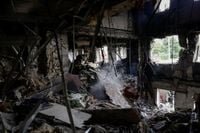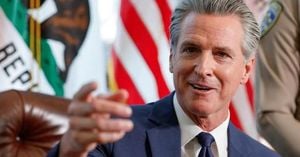On August 20, 2025, President Donald Trump made headlines with a decisive announcement: the United States is prepared to offer Ukraine air support as part of a potential peace agreement with Russia, but will not send American troops to the war-torn country. This commitment, confirmed by both the White House and European leaders, signals a new chapter in the international effort to end Russia’s ongoing invasion of Ukraine, which began in February 2022 and has claimed the lives or wounded more than one million people, according to analysts cited by Reuters.
Speaking on Fox News’ “Fox & Friends,” Trump explained the U.S. position: “When it comes to security, (Europeans) are willing to put people on the ground. We’re willing to help them with things, especially, probably … by air.” Trump’s comments underscore a division of labor among Ukraine’s Western allies, with European nations considering boots on the ground while the U.S. focuses on air-based support and coordination. The president did not elaborate on the specific form this air support might take, leaving open possibilities that range from missile defense systems to fighter jets enforcing a no-fly zone.
White House press secretary Karoline Leavitt reinforced Trump’s message at a news briefing, stating, “The president has definitively stated U.S. boots will not be on the ground in Ukraine, but we can certainly help in the coordination and perhaps provide other means of security guarantees to our European allies.” She confirmed that U.S. air support is “an option and a possibility,” but, like Trump, refrained from providing further details.
The announcement followed an extraordinary summit at the White House, where Trump, Ukrainian President Volodymyr Zelenskyy, French President Emmanuel Macron, British Prime Minister Keir Starmer, and other European leaders gathered for hours of talks. The goal: to bring an end to what Zelenskyy has called “Europe’s deadliest conflict in 80 years.” In a significant diplomatic breakthrough, Macron described Trump’s agreement to include the United States among the countries providing security guarantees to Ukraine as “a significant breakthrough.”
Yet, the path to peace remains anything but straightforward. Just hours after Zelenskyy’s meetings in Washington, Russia launched its largest air assault in more than a month, with 270 drones and 10 missiles targeting Ukraine. The strikes caused massive fires at energy facilities in the central Poltava region, home to Ukraine’s only oil refinery. The Ukrainian air force and the country’s energy ministry confirmed the scale and impact of the attack, highlighting the ongoing dangers faced by Ukrainian civilians and infrastructure.
As the diplomatic machinery churns, the question of how to structure a viable peace agreement looms large. Trump, in a separate interview with radio host Mark Levin, characterized his approach to negotiation as “probably instinct more than process.” He also conceded that Russian President Vladimir Putin might not be ready to make a deal, saying, “We’re going to find out about President Putin in the next couple of weeks.”
Ukrainian President Zelenskyy, for his part, hailed the White House talks as a “major step forward” and floated the idea of a trilateral meeting involving himself, Putin, and Trump. According to a White House official, Trump discussed Budapest as a possible venue for such a summit with Hungarian Prime Minister Viktor Orban. Istanbul and neutral Switzerland have also been mentioned as potential hosts, with the latter expressing readiness to facilitate talks. However, the Kremlin has yet to confirm Putin’s participation in any direct negotiations with Zelenskyy.
Trump’s stance on Ukraine’s future has not come without controversy. In his Fox News interview, he stated bluntly that Ukraine’s hopes of joining NATO and regaining the Crimean Peninsula from Russia are “impossible.” He elaborated, “Both of those things are impossible.” This position aligns with longstanding Russian demands, including the withdrawal of Ukrainian troops from the Donetsk and Luhansk regions and recognition of Crimea as Russian territory. The issue of Crimea, seized by Russian forces in 2014, has been a persistent stumbling block in all previous negotiations.
Despite the optimism expressed by some, the Kremlin remains publicly cautious. Yuri Ushakov, Putin’s foreign affairs adviser, acknowledged that discussions have included “raising the level of representatives” in peace talks but stopped short of confirming any bilateral or trilateral meetings. Russian Foreign Minister Sergei Lavrov added that contacts involving national leaders must be prepared “with the utmost thoroughness” and cannot be pursued merely for “media coverage or evening broadcasts.”
Meanwhile, Ukraine’s allies continue to coordinate their approach. Talks in the so-called Coalition of the Willing format took place on Tuesday, focusing on additional sanctions to pressure Russia and planning teams to develop security guarantees for Ukraine. NATO military leaders are expected to convene on August 21, with U.S. General Dan Caine, chairman of the Joint Chiefs of Staff, attending virtually, according to Reuters.
Not everyone is convinced that the U.S. security guarantees will amount to much. Neil Melvin, director at the International Security at the Royal United Services Institute, told Reuters, “They’re all tiptoeing around Trump” to avoid blame for any breakdown in the peace process. He added, “Trump’s statements on security guarantees were so vague it’s very hard to take them seriously.”
For the Ukrainian people, the stakes could not be higher. The war has devastated communities, destroyed infrastructure, and displaced millions. Every day that passes without a resolution brings new risks and suffering. While Trump’s assurances that “U.S. boots will not be on the ground” may offer some comfort to Americans wary of overseas entanglements, they also leave many questions unanswered about the durability and effectiveness of U.S. support for Ukraine.
As the world watches and waits for the next move from Washington, Moscow, and Kyiv, the future of Ukraine—and the broader security architecture of Europe—hangs in the balance. With all sides maneuvering carefully, the coming weeks will be critical in determining whether the glimmers of hope seen in Washington can translate into lasting peace on the ground.




